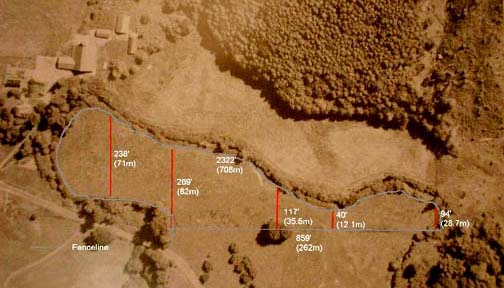 |
Creating Ponds Plastic Remediation Digging Out Stream and Ponds Wetland Habitat Planting Trees Maintaining Trees Site Plan Budget Preparation Trees & Shrubs |
 Wild Thyme Farm | T15N, R5W, S1 | May 2000 Objective: The plan objective is to establish a riparian forest buffer along a portion of Garrard Creek. The Wild Thyme Farm is located on Garrard Creek, a tributary of the Chehalis River in Grays Harbor County, Washington. A 10-year contract will be implemented under the Conservation Reserve Program (CRP) 2000 continuous signup for annual land rental payments and practice installation cost share assistance. Protection and/or enhancement of other natural resources such as soil, water and wildlife will be included.
SELECTED ALTERNATIVE Practice: Components: Tree/Shrub Establishment — Establish woody plants with appropriate site preparation by either artificially planting, seeding or encouraging natural regeneration for wood fiber production, recreation, aesthetics, erosion control, energy conservation, improved water quality and to provide wildlife habitat. Trees and shrubs will be established according to the Riparian Forest Buffer practice. OPERATION & MAINTENANCE The riparian forest buffer for the contract period will be maintained through exclusion of livestock, replanting any areas of unacceptable mortality and controlling competing vegetation and wildlife damage to tree seedlings. The buffer will be inspected periodically and protected from adverse impacts such as excessive vehicular and pedestrian traffic, pest infestations, pesticides use on adjacent lands, disease, insect infestations, wildlife damage and fire. Replacement of dead trees or shrubs and control of undesirable vegetative competition will be continued until the buffer is, or will progress to, a fully functional condition. Competing vegetation will be controlled in forest tree plantations until the woody plants are established and 80% survivability (400 trees/acre) is achieved. Replanting will be required when <80% of the stand survives. Determine cause of planting failure and take appropriate actions to prevent further loss of seedlings. Replace mortality the following planting season if needed to maintain desired stocking density. Neither harvesting or selling, nor otherwise make commercial use of trees or forage or other cover on the CRP land including the shearing or shaping of trees for future use as Christmas trees. Any use of fertilizers, herbicides and other chemicals to assure buffer function shall not compromise the intended purpose(s). Manage infestations of weeds, insects and disease to reduce adverse effect on plant growth, vigor and survival while protecting water quality. Apply herbicides only according to label instructions. All noxious weeds on the county noxious weed control list will be controlled as per requirement of the Grays Harbor County Weed Control Board and as necessary to ensure establishment of the CRP plant community. Other requirements: If pesticides are used, follow all applicable laws and regulations when mixing and using herbicides. Dispose of unused chemicals and containers according to manufacturer’s, federal, state, and local regulations. Management of permanent cover: Protect the plant community from destructive disease, fire and mechanical damage. However, incidental mortality, and variable vigor in individual plants is expected and often healthy for the overall community. Encourage diversity of native species throughout the life of the contract. All areas within the buffer, which are not planted with woody vegetation, will be maintained in herbaceous cover so that there is little or no exposed soil. Assuming that the buffer plantings are successful, a thinning of the RMZ would be recommended at stand age 15-20 years to maximize tree growth and to provide the necessary canopy openings for shrub and herbaceous understory growth. In landscape areas, supplemental watering or moisture conserving practices may be desirable to ensure adequate tree and shrub survival when more than two months of the growing season is droughty and the soil has a low water holding capacity (<0.1 inch/inch in the top 12 inches). Livestock will be excluded from the buffer. Follow up maintenance of competing vegetation (grass) will be controlled by mechanical means (i.e.: mowing). It was determined that with the use of the hygro-tiller and follow-up mowing of grass, that tree shelters will not be necessary for animal damage control of deer, beaver and rodents. Primary Nesting Season — The CRP cover will not be disturbed from April 1 through August 1 during the primary nesting season. The buffer will be maintained throughout the life of the CRP contract by replanting any larger "holes" of tree mortality, controlling any subsequent competing vegetation that would endanger the survival of the tree seedlings and by controlling any animal damage such as mice, deer, elk or beaver that would threaten the survival of the trees.
The buffer will be maintained throughout the life of the CRP contract by replanting any larger "holes" of tree mortality, controlling any subsequent competing vegetation that would endanger the survival of the tree seedlings and by controlling any animal damage such as mice, deer, elk or beaver that would threaten the survival of the trees. |
|
|
|
|
|
www.wildthymefarm.com © 1998-2009 • 72 Mattson Road, Oakville WA 98568 USA. Tel: (360) 273-8892 |
